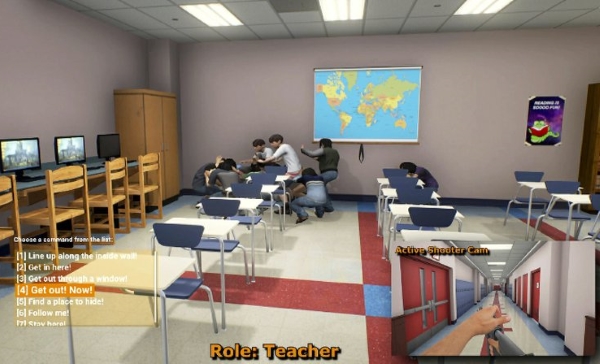[This story from The Verge summarizes and provides links to other coverage of a new application of presence-evoking technology: to simulate and prepare teachers for a school shooting. Some of the important ethical issues are highlighted at the end; the AP story includes a 2:19 minute video report; and the Gizmodo story notes that “It’s a dark irony that after 1999’s Columbine High School shooting, parents, teachers, and lawmakers tried to blame video games. Now, in 2018, VR simulations are attempting to prepare parents and teachers to save lives during similar shootings.” –Matthew]

The Army and DHS are making a virtual school shooting simulator for teachers
By Adi Robertson
Jan 5, 2018
The US Army and the Department of Homeland Security are designing a simulation of school shooting situations for teachers. Multiple players take the role of a teacher trying to keep students safe during a shooting; a law enforcement officer trying to apprehend the shooter; and the shooter, whose avatar may be that of an adult or a child. It’s a grim project, but one that the creators hope will help teachers stay calm in a real emergency.
The project is based on a multipurpose Homeland Security simulator called the Enhanced Dynamic Geo-Social Environment, or EDGE. A mass-shooting scenario for first responders launched in mid-2017, and this is supposed to launch in the spring. As Gizmodo writes, teachers in the school-specific version get prompts to do things like lock the doors and windows, and they can give students instructions like “follow me” or “find a place to hide.” Virtual children might cry or panic, and teachers listen for the direction of simulated gunshots to deduce the shooter’s location. (While Gizmodo refers to it as a virtual reality experience, a Glixel report says this isn’t the case.)
Just about every detail in the shooting simulator sounds horrifying, and some of the quotes in news reports are unsettlingly flippant; The Associated Press quotes a supportive nonprofit operator who calls it “a really cool and engaging way … to think about school safety.” An earlier EDGE press release boasts about using the same game engine that powers Mortal Kombat and BioShock.
But a Glixel interview with DHS spokesperson John Verrico helps put the program’s creepiest aspects in perspective. Verrico stresses that this won’t be released to the public, only to pre-vetted schools and first responders. The shooter character is supposed to be played by a police officer or first responder, who can act out the scenario more realistically than a programmed AI. There’s no “winning” the simulation, Verrico says, and he disputes the idea that it’s even a game. It sounds more like a virtual version of physical safety drills, made in hopes that teachers will remember some of this interactive training if they ever face a real shooter.
Still, as some people have pointed out online, it’s frustrating to see so much sophisticated engineering go toward making the best of mass shootings — while opportunities to prevent them altogether, like letting the CDC fund studies about gun violence, get left on the table.